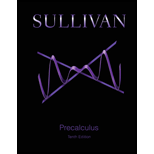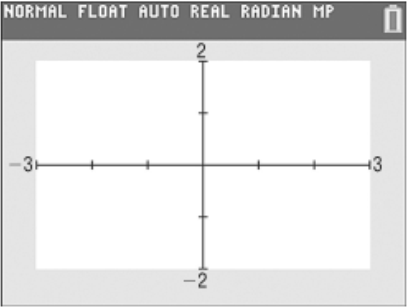
Precalculus (10th Edition)
10th Edition
ISBN: 9780321979070
Author: Michael Sullivan
Publisher: PEARSON
expand_more
expand_more
format_list_bulleted
Concept explainers
Textbook Question
Chapter B.1, Problem 6E
In Problems

Expert Solution & Answer
Want to see the full answer?
Check out a sample textbook solution
Students have asked these similar questions
The spread of an infectious disease is often modeled using the following autonomous differential equation:
dI
-
- BI(N − I) − MI,
dt
where I is the number of infected people, N is the total size of the population being modeled, ẞ is a constant determining the rate of
transmission, and μ is the rate at which people recover from infection.
Close
a) (5 points) Suppose ẞ = 0.01, N = 1000, and µ = 2. Find all equilibria.
b) (5 points) For the equilbria in part a), determine whether each is stable or unstable.
c) (3 points) Suppose ƒ(I) = d. Draw a phase plot of f against I. (You can use Wolfram Alpha or Desmos to plot the function, or draw the
dt
function by hand.) Identify the equilibria as stable or unstable in the graph.
d) (2 points) Explain the biological meaning of these equilibria being stable or unstable.
Find the indefinite integral.
Check
Answer:
7x
4 + 1x
dx
show sketch
Chapter B Solutions
Precalculus (10th Edition)
Ch. B.1 - In Problems determine the coordinates of the...Ch. B.1 - In Problems determine the coordinates of the...Ch. B.1 - In Problems determine the coordinates of the...Ch. B.1 - In Problems determine the coordinates of the...Ch. B.1 - In Problems 510, determine the viewing window...Ch. B.1 - In Problems 510, determine the viewing window...Ch. B.1 - In Problems 510, determine the viewing window...Ch. B.1 - In Problems 510, determine the viewing window...Ch. B.1 - In Problems determine the viewing window...Ch. B.1 - In Problems 1116, select a setting so that each of...
Ch. B.1 - In Problems select a setting so that each of the...Ch. B.1 - In Problems select a setting so that each of the...Ch. B.1 - In Problems select a setting so that each of the...Ch. B.1 - In Problems 1116, select a setting so that each of...Ch. B.1 - In Problems 1116, select a setting so that each of...Ch. B.1 - In Problems select a setting so that each of the...Ch. B.2 - In Problems 116, graph each equation using the...Ch. B.2 - In Problems graph each equation using the...Ch. B.2 - In Problems 116, graph each equation using the...Ch. B.2 - In Problems 116, graph each equation using the...Ch. B.2 - In Problems graph each equation using the...Ch. B.2 - In Problems graph each equation using the...Ch. B.2 - In Problems 116, graph each equation using the...Ch. B.2 - In Problems 116, graph each equation using the...Ch. B.2 - In Problems graph each equation using the...Ch. B.2 - In Problems 116, graph each equation using the...Ch. B.2 - In Problems graph each equation using the...Ch. B.2 - In Problems graph each equation using the...Ch. B.2 - In Problems 116, graph each equation using the...Ch. B.2 - In Problems 116, graph each equation using the...Ch. B.2 - In Problems graph each equation using the...Ch. B.2 - In Problems 116, graph each equation using the...Ch. B.2 - 1732. For each of the above equations, create a...Ch. B.2 - For each of the above equations, create a table,...Ch. B.2 - For each of the above equations, create a table,...Ch. B.2 - For each of the above equations, create a table,...Ch. B.2 - 1732. For each of the above equations, create a...Ch. B.2 - 1732. For each of the above equations, create a...Ch. B.2 - 1732. For each of the above equations, create a...Ch. B.2 - For each of the above equations, create a table,...Ch. B.2 - 1732. For each of the above equations, create a...Ch. B.2 - For each of the above equations, create a table,...Ch. B.2 - For each of the above equations, create a table,...Ch. B.2 - 1732. For each of the above equations, create a...Ch. B.2 - For each of the above equations, create a table,...Ch. B.2 - 1732. For each of the above equations, create a...Ch. B.2 - 1732. For each of the above equations, create a...Ch. B.2 - For each of the above equations, create a table,...Ch. B.3 - In Problems use Zero (or ROOT) to approximate the...Ch. B.3 - In Problems 16, use Zero (or ROOT) to approximate...Ch. B.3 - In Problems 16, use Zero (or ROOT) to approximate...Ch. B.3 - In Problems 16, use Zero (or ROOT) to approximate...Ch. B.3 - In Problems use Zero (or ROOT) to approximate the...Ch. B.3 - In Problems use Zero (or ROOT) to approximate the...Ch. B.3 - In Problems 712, use Zero (or ROOT) to approximate...Ch. B.3 - In Problems use Zero (or ROOT) to approximate the...Ch. B.3 - In Problems 712, use Zero (or ROOT) to approximate...Ch. B.3 - In Problems use Zero (or ROOT) to approximate the...Ch. B.3 - In Problems use Zero (or ROOT) to approximate the...Ch. B.3 - In Problems 712, use Zero (or ROOT) to approximate...Ch. B.5 - Prob. 1ECh. B.5 - Prob. 2ECh. B.5 - Prob. 3ECh. B.5 - Prob. 4ECh. B.5 - Prob. 5ECh. B.5 - Prob. 6ECh. B.5 - Prob. 7ECh. B.5 - Prob. 8ECh. B.5 - If Xmin=4,Xmax=12, and Xscl=1, how should...Ch. B.5 - If and how should and be selected so that the...
Knowledge Booster
Learn more about
Need a deep-dive on the concept behind this application? Look no further. Learn more about this topic, calculus and related others by exploring similar questions and additional content below.Similar questions
- Find the indefinite integral. Check Answer: 7x 4 + 1x dxarrow_forwardQuestion 1: Evaluate the following indefinite integrals. a) (5 points) sin(2x) 1 + cos² (x) dx b) (5 points) t(2t+5)³ dt c) (5 points) √ (In(v²)+1) 4 -dv ขarrow_forwardFind the indefinite integral. Check Answer: In(5x) dx xarrow_forward
- Find the indefinite integral. Check Answer: 7x 4 + 1x dxarrow_forwardHere is a region R in Quadrant I. y 2.0 T 1.5 1.0 0.5 0.0 + 55 0.0 0.5 1.0 1.5 2.0 X It is bounded by y = x¹/3, y = 1, and x = 0. We want to evaluate this double integral. ONLY ONE order of integration will work. Good luck! The dA =???arrow_forward43–46. Directions of change Consider the following functions f and points P. Sketch the xy-plane showing P and the level curve through P. Indicate (as in Figure 15.52) the directions of maximum increase, maximum decrease, and no change for f. ■ 45. f(x, y) = x² + xy + y² + 7; P(−3, 3)arrow_forward
- EX-let d'be ametric on a vector space X induced from a norm hx and d defind by a Slab)= {od (a, if a = b (a,b)+is ab Show that cannot be induced froman norm on X. 2) let à be trivel metric show that I cannot be induced from an norm on X- 3) let M be closed subspace of anormed spacex Construct the space X/Mas a normed space. 4) let Mix be vector space of 2x3 matrices on R write with Prove convex set and hyper Plane of M 5) show that every a finite dimension subspace of anormed space is closed.arrow_forwardplease do #48arrow_forward43–46. Directions of change Consider the following functions f and points P. Sketch the xy-plane showing P and the level curve through P. Indicate (as in Figure 15.52) the directions of maximum increase, maximum decrease, and no change for f. ■ 45. f(x, y) = x² + xy + y² + 7; P(−3, 3)arrow_forward
arrow_back_ios
SEE MORE QUESTIONS
arrow_forward_ios
Recommended textbooks for you
 Algebra for College StudentsAlgebraISBN:9781285195780Author:Jerome E. Kaufmann, Karen L. SchwittersPublisher:Cengage Learning
Algebra for College StudentsAlgebraISBN:9781285195780Author:Jerome E. Kaufmann, Karen L. SchwittersPublisher:Cengage Learning Trigonometry (MindTap Course List)TrigonometryISBN:9781305652224Author:Charles P. McKeague, Mark D. TurnerPublisher:Cengage Learning
Trigonometry (MindTap Course List)TrigonometryISBN:9781305652224Author:Charles P. McKeague, Mark D. TurnerPublisher:Cengage Learning

Algebra for College Students
Algebra
ISBN:9781285195780
Author:Jerome E. Kaufmann, Karen L. Schwitters
Publisher:Cengage Learning

Trigonometry (MindTap Course List)
Trigonometry
ISBN:9781305652224
Author:Charles P. McKeague, Mark D. Turner
Publisher:Cengage Learning
Mod-01 Lec-01 Discrete probability distributions (Part 1); Author: nptelhrd;https://www.youtube.com/watch?v=6x1pL9Yov1k;License: Standard YouTube License, CC-BY
Discrete Probability Distributions; Author: Learn Something;https://www.youtube.com/watch?v=m9U4UelWLFs;License: Standard YouTube License, CC-BY
Probability Distribution Functions (PMF, PDF, CDF); Author: zedstatistics;https://www.youtube.com/watch?v=YXLVjCKVP7U;License: Standard YouTube License, CC-BY
Discrete Distributions: Binomial, Poisson and Hypergeometric | Statistics for Data Science; Author: Dr. Bharatendra Rai;https://www.youtube.com/watch?v=lHhyy4JMigg;License: Standard Youtube License